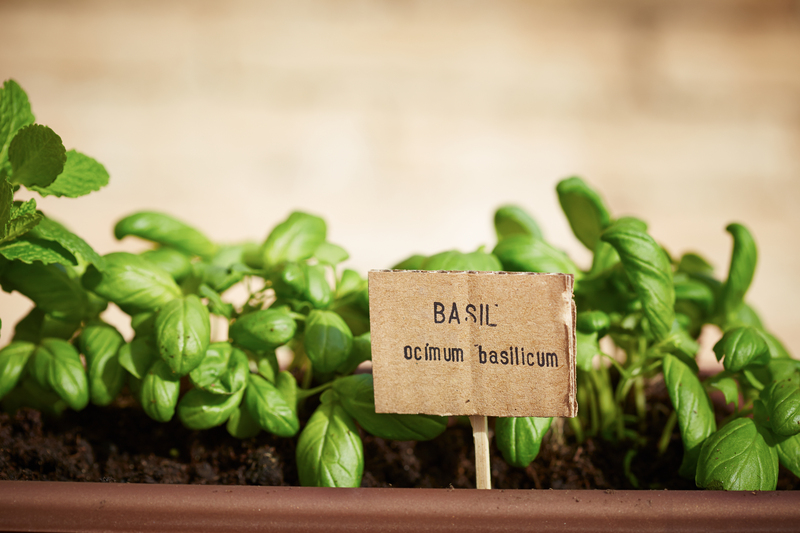Converting Kitchen Scraps into Rich Soil
Posted on 09/06/2025
Converting Kitchen Scraps into Rich Soil: The Ultimate Guide
Do you want to reduce food waste, enrich your garden, and do your part for the environment? Transforming your kitchen scraps into nourishing soil is simpler than you might think! This comprehensive guide delves into composting fundamentals, practical strategies, and creative tips for turning everyday organic waste into black gold for your plants.
Why Convert Kitchen Scraps to Soil?
Every year, millions of tons of organic waste from homes end up in landfills. Instead of letting useful nutrients be lost, you can repurpose kitchen scraps through composting, creating a sustainable cycle that benefits your plants and reduces your household's carbon footprint.
- Waste Reduction: Composting diverts valuable organic material from landfill.
- Soil Health: Homemade compost feeds your plants, improves soil texture, and introduces beneficial microorganisms.
- Cost Savings: No need to buy expensive commercial fertilizers or soil amendments.
- Environmental Benefits: Decomposing organics in landfills produce methane. Composting at home reduces greenhouse gases.
Eco-Friendly Gardening Starts in the Kitchen
When you hear the phrase converting kitchen scraps into rich soil, you might immediately think of a backyard compost heap. But the process can be scaled to fit any household, whether you live on a homestead or in an apartment!

The Science Behind Composting Kitchen Scraps
Composting is a natural process in which microorganisms break down organic materials, turning them into humus-rich soil. The secret to success lies in achieving the right balance of green and brown materials, moisture, oxygen, and temperature.
What Are Kitchen Scraps?
- Greens: Kitchen waste high in nitrogen, such as fruit and vegetable peels, coffee grounds, tea bags, and fresh grass clippings.
- Browns: Carbon-rich materials, like shredded paper, cardboard, dried leaves, and straw, which are essential for odor control and structure.
Creating thriving compost means giving microbes what they need: the right diet (greens and browns), enough air, and moisture. Maintaining this balance is key to converting kitchen scraps into usable, nutrient-dense soil.
Types of Composting Systems for Kitchen Waste
Depending on your space, needs, and preferences, you can choose from several effective composting systems for turning kitchen waste into fertile soil.
1. Traditional Backyard Compost Pile or Bin
- Size: Suitable for households with garden space.
- Process: Layer greens and browns, aerate regularly, and monitor moisture.
- Benefits: Handles larger volumes; easy to use for garden beds.
2. Worm Composting (Vermicomposting)
- Indoors or Outdoors: Works in apartments, garages, or patios.
- Special Worms: Red wigglers (Eisenia fetida) digest and transform scraps quickly.
- Compost Output: Castings (worm manure) are incredibly rich and beneficial for plants.
3. Bokashi Composting
- Fermentation Based: Uses microbes to pickle scraps anaerobically.
- Fast & Odor-Free: Can handle meat, dairy, and cooked foods--items typically excluded from other methods.
- Finish in Soil: After fermenting, bury the material or add to a traditional compost to complete decomposition.
4. Electric Countertop Composters
- Convenient: Transforms kitchen scraps into soil amendment in hours to days.
- Space-saving: Great for small homes, but output is not true compost--best mixed into traditional compost or garden beds.
What Kitchen Scraps Can You Compost?
Identifying what to compost and what to avoid is essential for successful results and to prevent unpleasant odors or animal attraction.
Compostable Kitchen Waste
- Fruit and vegetable peels, cores, and scraps
- Coffee grounds and filters
- Tea leaves and paper tea bags
- Eggshells (crushed)
- Nut shells (non-oily varieties)
- Bread and grains (in small amounts)
Kitchen Items to Avoid
- Meat, fish, and bones (unless using Bokashi)
- Dairy products
- Fats, oils, and greasy foods
- Large amounts of cooked food
- Glossy or coated paper, plastics, synthetic materials
When in doubt, stick to plant-based scraps and paper products as browns.
How to Start Composting Kitchen Scraps at Home
Step-by-Step Guide
-
Choose Your Composting Method
Assess your available space, household waste volume, and preference for indoor or outdoor systems. -
Set Up a Collection Container
Keep a ventilated bin or ceramic crock on your countertop to collect peels, cores, grounds, and more. Adding a paper liner or brown paper reduces odor. -
Build Your Pile or Fill Your Bin
Begin with a base of browns, add kitchen scraps daily, and alternate layers if possible. Cover the pile or bin to retain moisture and deter pests. -
Maintain the Balance
Compost works best with about 2-3 parts brown materials to 1 part green (kitchen waste). If it smells foul, add more browns; if slow, add more greens or a little water. -
Monitor & Turn (If Needed)
Aerate your compost every 1-2 weeks with a shovel or compost fork, especially in traditional pile systems. Worm and Bokashi bins need little mixing. -
Harvest Your Rich Soil
In 2-6 months, depending on the method, your kitchen waste will have broken down into dark, crumbly compost ready to enrich your garden.
Tips for Successful Composting
- Chop Scraps: Smaller pieces decompose faster, aiding in a quicker conversion to soil.
- Maintain Moisture: Your pile should feel like a wrung-out sponge--neither soggy nor dry.
- Provide Aeration: Airflow keeps microbes happy and odor in check.
- Store Scraps Properly: If you can't add scraps daily, freeze them to prevent smells and fruit flies.
- Location: Place your compost pile or bin where it's convenient but shady, and out of direct sun to avoid excessive drying.
Transforming Compost into Garden Gold
How to Use Finished Compost from Kitchen Waste
- Mulch flower beds and vegetable gardens
- Mix into potting soil for indoor and outdoor containers
- Top-dress lawns and around trees for a nutrient boost
- Create compost tea by steeping finished compost in water to use as a liquid fertilizer
Quality compost enriches your soil, helping plants grow stronger, retain water better, and resist pests naturally.
Common Problems and Solutions in Kitchen Scrap Composting
My Pile Smells Bad!
- Likely Cause: Too many wet "greens" and not enough dry browns or insufficient aeration.
- Solution: Mix in shredded paper, dry leaves, or cardboard and turn the pile.
Pile Not Decomposing?
- Likely Cause: Too dry, cold weather, or lack of nitrogen-rich material.
- Solution: Add more kitchen scraps, moisten slightly, and turn regularly.
Fruit Flies or Pests?
- Prevention: Always cover fresh food waste with a layer of browns, and keep bins closed or screened.
- Choose Secure Systems: Enclosed tumblers, bins, or worm towers keep animals and bugs away.
Advanced Tips for Mastering Composting Kitchen Leftovers
- Add Biochar: Charcoal boosts microbial activity and traps nutrients.
- Use Compost Accelerators: These can introduce more beneficial microbes or nitrogen for faster breakdown.
- Keep a Compost Journal: Note what you add, maintain, and harvest for better results over time.
- Share or Gift Surplus Compost: Enrich neighbors' gardens or local community projects.
Composting in Small Spaces: Urban and Apartment Solutions
If you live in a city or have no yard, you can still transform kitchen waste into fertile garden soil!
- Worm Bins: Compact, odorless, and fit easily under sinks or on balconies.
- Bokashi Buckets: Minimal space, process everything from fruit cores to cooked leftovers.
- Community Compost: Many cities have drop-off locations, or partner with neighbors to share bins.
- Electric Composters: Fast solution for busy lifestyles--dry, grind, and lightly compost scraps in hours.
Even with limited space, you can make a real impact by converting kitchen scraps into plant-nourishing soil.

The Environmental Impact: Why Every Scrapped Potato Peel Matters
When you embrace turning kitchen scraps into garden soil, you're helping reduce methane emissions and lessening municipal waste loads. The EPA notes that over 30% of trash is organic and compostable, meaning every home composting system helps the environment.
- Reduced landfill use and decomposition time
- Lower greenhouse gas emissions
- Healthier soil and water cycles
Conclusion: From Scraps to Soil - A Greener Home Starts with You
Converting your kitchen scraps into rich soil is one of the most effective and gratifying eco-friendly projects you can start today. With the right information, tools, and a bit of patience, your kitchen waste becomes a valuable resource, giving life back to your plants and gardens.
Whether you're composting in a backyard bin, a worm tower, or a countertop composter, the transformation from food waste to fertile earth is a reminder: there's no such thing as "waste"--only untapped potential for growth.
Ready to start composting your kitchen scraps? Select a method that fits your lifestyle, gather your organic leftovers, and join the millions worldwide nurturing sustainable, healthy environments--one banana peel at a time.

